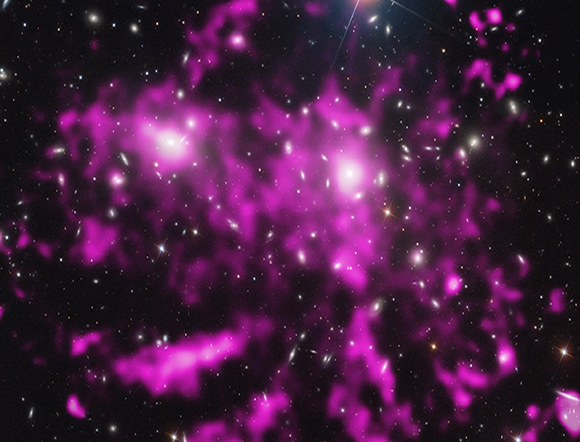
This picture shows the very large, very distant and very gassy Coma Cluster. It's a giant cluster of over 1000 galaxies that are all bound together by gravity. If you take a close look, you can make out the yellow-white shapes of galaxies scattered across the picture. The pink blobs show arms of multi-million degree gas, hot enough to cook your lungs in half a breath.
All big clusters of galaxies contain this very hot gas. The gas sends out lots of powerful X-rays because it's so hot, and these are what we can see in pink here. You can't see X-rays with your eyes, so astronomers have coloured them in pink. This gas is actually a very helpful tool for us, because the amount of material in the cluster can be measured using just the temperature of the gas! The hotter the gas, the more material there is!
Our Galaxy is also part of a group of galaxies, called the Local Group. Our cluster is also filled with gas, but it's so spread out that we don't see it when we look into the night sky. And because the Local Group is much smaller than the Coma Cluster, the gas around our galaxy isn't nearly as hot.
The gas in this picture also tells another story. The shape of these pink clouds and how they are spread throughout the cluster give us clues into how the Coma Cluster has grown. They show us that smaller groups of galaxies and smaller galaxy clusters have crashed and combined over time. The final result is the colossal Coma Cluster we see today, one of the biggest structures in the entire Universe!
Cool fact: The Coma Cluster is very far away. If you started travelling there today in a giant starship, with unlimited food, water and oxygen, and then your children took over the mission when you died, followed by their children and so on, it would take 9 million generations of your offspring before your ship arrived at the cluster! And this is if you're doing the impossible and moving at the speed of the fastest thing in the Universe - light.
Watch the video podcast
Do you want to learn more about this topic?
Visit the Chandra field guide or send us your questions in an email: cxcpub@cfa.harvard.edu
In cooperation with Space Scoop: Bringing news from across the Universe to children all around the world. Universe Awareness and the Chandra X-ray Observatory
| Children & Online Privacy |



